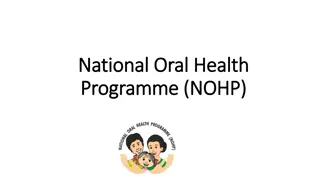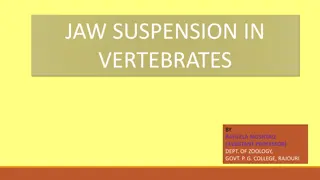Oral Health Management in Patients at Risk of Medication-related Osteonecrosis of the Jaw
The Scottish Dental Clinical Effectiveness Programme (SDCEP) provides evidence-based guidance to support quality oral health care for patients at risk of medication-related osteonecrosis of the jaw (MRONJ). This guidance aims to minimize the risk of MRONJ and encourage consistent oral health management practices. The guidance was developed by a Guidance Development Group of dental and medical professionals, along with patient representatives, and underwent thorough evidence appraisal and public consultation. SDCEP's work is accredited by NICE, ensuring its credibility in the field of oral health care.
Download Presentation

Please find below an Image/Link to download the presentation.
The content on the website is provided AS IS for your information and personal use only. It may not be sold, licensed, or shared on other websites without obtaining consent from the author.If you encounter any issues during the download, it is possible that the publisher has removed the file from their server.
You are allowed to download the files provided on this website for personal or commercial use, subject to the condition that they are used lawfully. All files are the property of their respective owners.
The content on the website is provided AS IS for your information and personal use only. It may not be sold, licensed, or shared on other websites without obtaining consent from the author.
E N D
Presentation Transcript
Oral Health Management of Patients at Risk of Medication-related Osteonecrosis of the Jaw Published March 2017 Quality Education for a Healthier Scotland
What is SDCEP? The Scottish Dental Clinical Effectiveness Programme (SDCEP) is part of the Dental Directorate within NHS Education for Scotland SDCEP develops guidance on priority topics for oral health care that aims to be evidence-based, practical and user friendly to support quality care SDCEP guidance informs under-graduate and post- graduate education and training as well as daily dental practice in Scotland and beyond SDCEP is also involved in implementation research to understand how to bring about changes in practice Quality Education for a Healthier Scotland
Background to the Guidance Patients who are taking anti-resorptive or anti-angiogenic drugs have a small risk of developing medication-related osteonecrosis of the jaw (MRONJ). This condition may be more prevalent in patients who have dental procedures which impact on bone, for example extractions. Dental practitioners are likely to see patients who are taking these drugs in primary care as they are prescribed to prevent, as well as to treat, a wide variety of medical conditions. This guidance aims to help minimise the risk of MRONJ developing in these patients and to encourage a consistent approach to their oral health management. This guidance is an update to the SDCEP Oral Health Management of Patients Prescribed Bisphosphonates guidance Quality Education for a Healthier Scotland
How was the guidance produced? A Guidance Development Group (GDG), comprising a group of dental and medical professionals with a particular interest in this topic plus two patient representatives, was convened to write the guidance SDCEP Research Lead facilitated evidence search and appraisal Recommendations based on considered judgement of the evidence Full public consultation and peer review before publication Quality Education for a Healthier Scotland
NICE Accreditation NICE has accredited the process used by the Scottish Dental Clinical Effectiveness Programme to produce its Oral Health Management of Patients at Risk of Medication-related Osteonecrosis of the Jaw guidance. Accreditation is valid for 5 years from 15 March 2016. More information on accreditation can be viewed at www.nice.org.uk/accreditation. NICE_Accreditation_CMYK Quality Education for a Healthier Scotland
Format The guidance provides evidence-based recommendations in the following areas: Classification of Patient Risk Initial Management of Patients at Risk of MRONJ Ongoing Management of Patients at Risk of MRONJ Key recommendations are highlighted at the beginning of each section with brief summaries of the evidence underpinning the guidance recommendations throughout the text. A more in-depth discussion of the evidence is provided in a separate Guidance Development Methodology document. Quality Education for a Healthier Scotland
Classification of Patient Risk Assess whether a patient taking anti-resorptive or anti- angiogenic drugs is at low risk or higher risk of developing MRONJ based on their medical condition, type and duration of drug therapy and any other complicating factors and record this in the patient s clinical notes Quality Education for a Healthier Scotland
Initial Management of Patients at Risk of MRONJ Before commencement of anti-resorptive or anti-angiogenic drug therapy, or as soon as possible thereafter, aim to get the patient as dentally fit as feasible, prioritising preventive care. Higher risk cancer patients should preferably undergo a thorough dental assessment, with remedial dental treatment where required, prior to commencement of the drug therapy. Advise the patient that, due to the medication they are taking, there may be a risk of developing MRONJ but ensure that they understand that the risk is small. Ensure that the patient is not discouraged from taking their medication or from undergoing dental treatment. Record that this advice has been given. Quality Education for a Healthier Scotland
Initial Management of Patients at Risk of MRONJ Give personalised preventive advice to help the patient optimise their oral health. Prioritise care that will reduce mucosal trauma or may help avoid future extractions or any oral surgery or procedures that may impact on bone. For medically complex patients for whom you would normally seek advice, including higher risk patients who are being treated with anti-resorptive or anti-angiogenic drugs for the management of cancer, consider consulting a specialist with regards to clinical assessment and treatment planning. Quality Education for a Healthier Scotland
Continuing Management of Patients at Risk of MRONJ Carry out all routine dental treatment as normal and continue to provide personalised preventive advice in primary care. Perform straightforward extractions and other bone- impacting treatments in low risk patients in primary care. Adopt a more conservative approach in higher risk patients, giving greater consideration to other, less invasive alternative treatment options before performing extractions and other bone-impacting treatments in primary care. Quality Education for a Healthier Scotland
Continuing Management of Patients at Risk of MRONJ Do not prescribe antibiotic or antiseptic prophylaxis following extractions or other bone-impacting treatments specifically to reduce the risk of MRONJ. Review healing. If the extraction socket is not healed at 8 weeks, and you suspect that the patient has MRONJ, refer to a specialist as per local protocols. If you suspect a patient has spontaneous MRONJ, refer to a specialist as per local protocols. Quality Education for a Healthier Scotland
Oral Health Management of Patients at Risk of MRONJ Where a patient initially presents with an established history of anti- resorptive or anti- angiogenic drug use, follow the advice for extractions or other procedures which impact on bone in the lower section. Quality Education for a Healthier Scotland
Supporting Tools Guidance in Brief a summary of the main recommendations for the busy practitioner Recommendations for Prescribers and Dispensers Patient leaflets for patients with osteoporosis/non-malignant diseases of bone and for cancer patients Accessible versions Quality Education for a Healthier Scotland
More Information The full guidance, Guidance in Brief and Supporting Tools are available via the SDCEP website www.sdcep.org.uk For further information contact SDCEP at scottishdental.cep@nes.scot.nhs.uk Other SDCEP guidance publications are also available via the SDCEP website Quality Education for a Healthier Scotland























